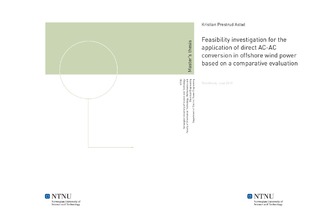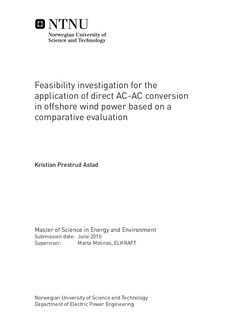| dc.contributor.advisor | Molinas, Marta | nb_NO |
| dc.contributor.author | Astad, Kristian Prestrud | nb_NO |
| dc.date.accessioned | 2014-12-19T13:51:31Z | |
| dc.date.available | 2014-12-19T13:51:31Z | |
| dc.date.created | 2010-09-09 | nb_NO |
| dc.date.issued | 2010 | nb_NO |
| dc.identifier | 349987 | nb_NO |
| dc.identifier | ntnudaim:5518 | nb_NO |
| dc.identifier.uri | http://hdl.handle.net/11250/256675 | |
| dc.description.abstract | In this thesis a feasibility study of a direct AC-AC converter for wind power application has been performed. Two three-phase voltages are converted to a single phase square wave for input to a high-frequency transformer and then rectified. No DC-capacitor is present in the converter and bi-directional switches consisting of two reverse blocking IGBTs allow the direct AC-AC conversion. Efficiency, silicon usage, price and output quality of the converter were to be compared with a reference case and conclusions to be drawn from the obtained results. The price comparison could not be finalized due to lack of price data. The efficiencies were found to be 97:7 % for both the converter setups while the silicon usage was 4:6 % lower for the direct AC-AC solution. A back-to-back converter was used as the reference case. The harmonic content was less in the back-to-back converter and DC-offsets in the phase currents caused power oscillations for both converters but they were higher in the direct AC-AC converter. The reference case needs more switches than the direct AC-AC solution if put in a split drivetrain configuration and DC-capacitors are also present in the former. The size is therefore expected to be lower for the AC-AC solution. The obtained results was used to conclude that the direct AC-AC solution is a feasible solution for a split drivetrain configurated wind turbine with multiple generators. The voltage of the square wave in the direct AC-AC converter needs to be two times higher than the DC-voltage in the reference case to obtain the same rated voltage in the generators when they are supplying power simultaneously. The switch voltage ratings must then be increased accordingly. Another application was proposed to better exploit the converter topology examined and to avoid the doubled voltage rating. An isolated power system with a time varying energy source such as a wind turbine needs an auxiliary power source to be able to supply the full load power when the other is unavailable. The double input converter can then control the two generators so that a constant output power is achieved. The square wave voltage amplitude can then be dimensioned from the load power only rather than for the total rated power in the two generators. It is therefore halved and the voltage stresses on the switches are similarly reduced. | nb_NO |
| dc.language | eng | nb_NO |
| dc.publisher | Institutt for elkraftteknikk | nb_NO |
| dc.subject | ntnudaim | no_NO |
| dc.subject | SIE5 energi og miljø | no_NO |
| dc.subject | Elektrisk energiteknikk | no_NO |
| dc.title | Feasibility investigation for the application of direct AC-AC conversion in offshore wind power based on a comparative evaluation | nb_NO |
| dc.type | Master thesis | nb_NO |
| dc.source.pagenumber | 110 | nb_NO |
| dc.contributor.department | Norges teknisk-naturvitenskapelige universitet, Fakultet for informasjonsteknologi, matematikk og elektroteknikk, Institutt for elkraftteknikk | nb_NO |

